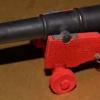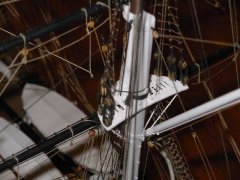-
Posts
597 -
Joined
-
Last visited
Reputation Activity
-
 Dziadeczek got a reaction from catopower in Question about rigging leech ropes around silk-like thin sails
Dziadeczek got a reaction from catopower in Question about rigging leech ropes around silk-like thin sails
This is a corner of a sail from the "Star of India" in San Diego.
-
 Dziadeczek got a reaction from ibozev in Question about rigging leech ropes around silk-like thin sails
Dziadeczek got a reaction from ibozev in Question about rigging leech ropes around silk-like thin sails
This is a corner of a sail from the "Star of India" in San Diego.
-
 Dziadeczek got a reaction from Knocklouder in Question about rigging leech ropes around silk-like thin sails
Dziadeczek got a reaction from Knocklouder in Question about rigging leech ropes around silk-like thin sails
This is a corner of a sail from the "Star of India" in San Diego.
-
 Dziadeczek got a reaction from catopower in Question about rigging leech ropes around silk-like thin sails
Dziadeczek got a reaction from catopower in Question about rigging leech ropes around silk-like thin sails
I am sure there are many different ways to do it and some members will explain their techniques, but I do it in the following faschion:
I use a very thin cotton fabric for my sails, instead of silkspan. I found it in my local fabric store (www.moodfabrics,com) a fabric known as cotton muslin, already factory coloured into a nice cream (eggshell) color - perfect for sails, so I don't need to color it by myself. It is used primarilly for linings for suits or similar. But my model is in 1:48 scale, so this muslin is barely thin enough for my sails. It might be too thick for your model though, if your scale is smaller.
I wanted to show all sewn details of my sails, and I feared that silkspan, being soooo thin and delicate, would not allow this...
After preparing my sails in the traditional way, I attach (glue) to their edges a bolt rope, making sure that it isn't attached to the edge of a sail, but instead it lays ON the edge, on the AFT side of the sail. After the glue (white glue like Elmer's), slightly diluted with water, has dried, I sew the rope with a very thin needle and thin thread of almost the same (only slightly darker) color that the sail itself, like on the attached pic. I found out that if I leave the rope only glued there, it has a tendency to split from the sail, if you manipulate it with your fingers. Sewing it, reinforces the bond and secures it.
It is an extremely tedious and time consuming process (if you think, tying ratlines is tedious, think again!), I work with magnifier Optivisor and have a thimble on my finger to push the needle through the slightly stiffened (by glue) fabric. I place the sail on a rubber mat, like yours, but on top of that mat I place a piece of ordinary cardboard and only then I place my sail on top of it. The cardboard allows me to push the needle through the rope and the sail and a bit more (perhaps 2 to 3 mm - the thicknes of cardboard) on the other side. It is easier than, to push it all the way through. I sew through the middle of the rope and through the sail, just perhaps 1 mm from its edge. After the sewing, the thread is nearly invisible, only from a very close distance, say a few cm, similar to full size sails.
-
 Dziadeczek got a reaction from ibozev in Question about rigging leech ropes around silk-like thin sails
Dziadeczek got a reaction from ibozev in Question about rigging leech ropes around silk-like thin sails
I am sure there are many different ways to do it and some members will explain their techniques, but I do it in the following faschion:
I use a very thin cotton fabric for my sails, instead of silkspan. I found it in my local fabric store (www.moodfabrics,com) a fabric known as cotton muslin, already factory coloured into a nice cream (eggshell) color - perfect for sails, so I don't need to color it by myself. It is used primarilly for linings for suits or similar. But my model is in 1:48 scale, so this muslin is barely thin enough for my sails. It might be too thick for your model though, if your scale is smaller.
I wanted to show all sewn details of my sails, and I feared that silkspan, being soooo thin and delicate, would not allow this...
After preparing my sails in the traditional way, I attach (glue) to their edges a bolt rope, making sure that it isn't attached to the edge of a sail, but instead it lays ON the edge, on the AFT side of the sail. After the glue (white glue like Elmer's), slightly diluted with water, has dried, I sew the rope with a very thin needle and thin thread of almost the same (only slightly darker) color that the sail itself, like on the attached pic. I found out that if I leave the rope only glued there, it has a tendency to split from the sail, if you manipulate it with your fingers. Sewing it, reinforces the bond and secures it.
It is an extremely tedious and time consuming process (if you think, tying ratlines is tedious, think again!), I work with magnifier Optivisor and have a thimble on my finger to push the needle through the slightly stiffened (by glue) fabric. I place the sail on a rubber mat, like yours, but on top of that mat I place a piece of ordinary cardboard and only then I place my sail on top of it. The cardboard allows me to push the needle through the rope and the sail and a bit more (perhaps 2 to 3 mm - the thicknes of cardboard) on the other side. It is easier than, to push it all the way through. I sew through the middle of the rope and through the sail, just perhaps 1 mm from its edge. After the sewing, the thread is nearly invisible, only from a very close distance, say a few cm, similar to full size sails.
-
 Dziadeczek got a reaction from Knocklouder in Question about rigging leech ropes around silk-like thin sails
Dziadeczek got a reaction from Knocklouder in Question about rigging leech ropes around silk-like thin sails
I am sure there are many different ways to do it and some members will explain their techniques, but I do it in the following faschion:
I use a very thin cotton fabric for my sails, instead of silkspan. I found it in my local fabric store (www.moodfabrics,com) a fabric known as cotton muslin, already factory coloured into a nice cream (eggshell) color - perfect for sails, so I don't need to color it by myself. It is used primarilly for linings for suits or similar. But my model is in 1:48 scale, so this muslin is barely thin enough for my sails. It might be too thick for your model though, if your scale is smaller.
I wanted to show all sewn details of my sails, and I feared that silkspan, being soooo thin and delicate, would not allow this...
After preparing my sails in the traditional way, I attach (glue) to their edges a bolt rope, making sure that it isn't attached to the edge of a sail, but instead it lays ON the edge, on the AFT side of the sail. After the glue (white glue like Elmer's), slightly diluted with water, has dried, I sew the rope with a very thin needle and thin thread of almost the same (only slightly darker) color that the sail itself, like on the attached pic. I found out that if I leave the rope only glued there, it has a tendency to split from the sail, if you manipulate it with your fingers. Sewing it, reinforces the bond and secures it.
It is an extremely tedious and time consuming process (if you think, tying ratlines is tedious, think again!), I work with magnifier Optivisor and have a thimble on my finger to push the needle through the slightly stiffened (by glue) fabric. I place the sail on a rubber mat, like yours, but on top of that mat I place a piece of ordinary cardboard and only then I place my sail on top of it. The cardboard allows me to push the needle through the rope and the sail and a bit more (perhaps 2 to 3 mm - the thicknes of cardboard) on the other side. It is easier than, to push it all the way through. I sew through the middle of the rope and through the sail, just perhaps 1 mm from its edge. After the sewing, the thread is nearly invisible, only from a very close distance, say a few cm, similar to full size sails.
-
 Dziadeczek got a reaction from Mark P in Focus Stacking
Dziadeczek got a reaction from Mark P in Focus Stacking
This was my very first attempt at focus stacking, using my old Nikon d200, standard kit zoom lens 18-70, a tripod, no rails. Merging on Photoshop.
I am quite satisfied with the result. What do you think, guys?
Thomas
-
 Dziadeczek got a reaction from thibaultron in Making a Silk-fabric(?) Sail
Dziadeczek got a reaction from thibaultron in Making a Silk-fabric(?) Sail
There is available a very good little brochure by David Antscherl on making model sails from silkspan, if you decide to use this medium.
-
 Dziadeczek got a reaction from bdgiantman2 in La Créole 1827 by archjofo - Scale 1/48 - French corvette
Dziadeczek got a reaction from bdgiantman2 in La Créole 1827 by archjofo - Scale 1/48 - French corvette
The best and most detailed rigging I have ever seen on a model!!! 😃 👍
-
 Dziadeczek got a reaction from mtaylor in Making a Silk-fabric(?) Sail
Dziadeczek got a reaction from mtaylor in Making a Silk-fabric(?) Sail
There is available a very good little brochure by David Antscherl on making model sails from silkspan, if you decide to use this medium.
-
 Dziadeczek got a reaction from Dave_E in Making a Silk-fabric(?) Sail
Dziadeczek got a reaction from Dave_E in Making a Silk-fabric(?) Sail
There is available a very good little brochure by David Antscherl on making model sails from silkspan, if you decide to use this medium.
-
 Dziadeczek got a reaction from modeller_masa in Making a Silk-fabric(?) Sail
Dziadeczek got a reaction from modeller_masa in Making a Silk-fabric(?) Sail
There is available a very good little brochure by David Antscherl on making model sails from silkspan, if you decide to use this medium.
-
 Dziadeczek got a reaction from etubino in Rattlesnake by javajohn - Model Shipways - 1:64
Dziadeczek got a reaction from etubino in Rattlesnake by javajohn - Model Shipways - 1:64
I carved my own transom from a thin piece of wood (cherry, if I remember).
-
 Dziadeczek got a reaction from BobG in La Créole 1827 by archjofo - Scale 1/48 - French corvette
Dziadeczek got a reaction from BobG in La Créole 1827 by archjofo - Scale 1/48 - French corvette
The best and most detailed rigging I have ever seen on a model!!! 😃 👍
-
 Dziadeczek got a reaction from WalrusGuy in La Créole 1827 by archjofo - Scale 1/48 - French corvette
Dziadeczek got a reaction from WalrusGuy in La Créole 1827 by archjofo - Scale 1/48 - French corvette
The best and most detailed rigging I have ever seen on a model!!! 😃 👍
-
 Dziadeczek got a reaction from Gahm in La Créole 1827 by archjofo - Scale 1/48 - French corvette
Dziadeczek got a reaction from Gahm in La Créole 1827 by archjofo - Scale 1/48 - French corvette
The best and most detailed rigging I have ever seen on a model!!! 😃 👍
-
 Dziadeczek got a reaction from shipman in La Créole 1827 by archjofo - Scale 1/48 - French corvette
Dziadeczek got a reaction from shipman in La Créole 1827 by archjofo - Scale 1/48 - French corvette
The best and most detailed rigging I have ever seen on a model!!! 😃 👍
-
 Dziadeczek got a reaction from Peta_V in La Créole 1827 by archjofo - Scale 1/48 - French corvette
Dziadeczek got a reaction from Peta_V in La Créole 1827 by archjofo - Scale 1/48 - French corvette
The best and most detailed rigging I have ever seen on a model!!! 😃 👍
-
 Dziadeczek got a reaction from archjofo in La Créole 1827 by archjofo - Scale 1/48 - French corvette
Dziadeczek got a reaction from archjofo in La Créole 1827 by archjofo - Scale 1/48 - French corvette
The best and most detailed rigging I have ever seen on a model!!! 😃 👍
-
 Dziadeczek got a reaction from mtaylor in La Créole 1827 by archjofo - Scale 1/48 - French corvette
Dziadeczek got a reaction from mtaylor in La Créole 1827 by archjofo - Scale 1/48 - French corvette
The best and most detailed rigging I have ever seen on a model!!! 😃 👍
-
 Dziadeczek got a reaction from Keith Black in La Créole 1827 by archjofo - Scale 1/48 - French corvette
Dziadeczek got a reaction from Keith Black in La Créole 1827 by archjofo - Scale 1/48 - French corvette
The best and most detailed rigging I have ever seen on a model!!! 😃 👍
-
 Dziadeczek reacted to archjofo in La Créole 1827 by archjofo - Scale 1/48 - French corvette
Dziadeczek reacted to archjofo in La Créole 1827 by archjofo - Scale 1/48 - French corvette
@French Mr Bean
@Gahm
@jdbondy
@dvm27
Hello,
Thank you in advance for your nice comments and the many "likes".
I am always happy and motivated by positive feedback. Constructive criticism and suggestions are still very welcome.
Greg, I'm also very glad that my rigging inspires you.
Continuation: Standing rigging for jib and outer jib boom - Bâton de foc et bâton de clinfoc
First I had to attach the jib boom. I lined the jib boom passage in the cap of the bowsprit with a specially split leather (d=0.2 mm). The jib boom was placed on the prepared wooden pad or spacer so that it runs parallel to the bowsprit. Then I lashed the jib boom to the bowsprit analogous to bowsprit gammoning.
I added small details to the cap, as can be seen in the last picture. These are single blocks (l = 3.5 mm) on each side for the bowlines of the fore topsail. Next to the block you can also see the leather lining mentioned at the beginning.
Sequel follows …
-
 Dziadeczek got a reaction from druxey in Jumbo sail "construction" detail question
Dziadeczek got a reaction from druxey in Jumbo sail "construction" detail question
And this one is from Harland.
-
 Dziadeczek got a reaction from juhu in Jumbo sail "construction" detail question
Dziadeczek got a reaction from juhu in Jumbo sail "construction" detail question
And this one is from Harland.
-
 Dziadeczek got a reaction from thibaultron in Jumbo sail "construction" detail question
Dziadeczek got a reaction from thibaultron in Jumbo sail "construction" detail question
And this one is from Harland.











.thumb.jpg.62d1d69fed1f32364417cb1f9cdeb009.jpg)




